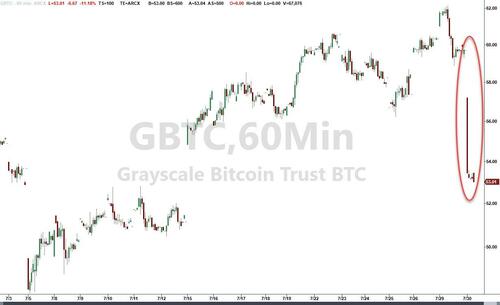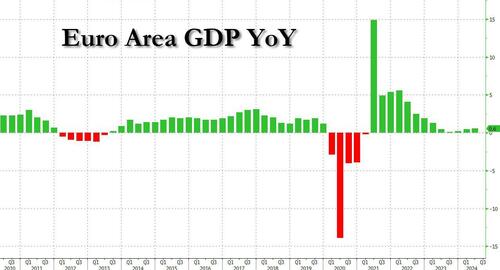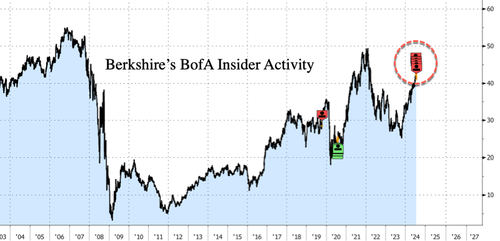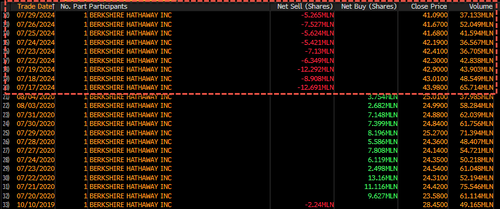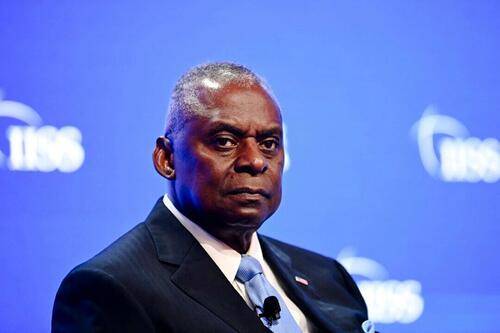Authored by Thi Thuy Van Dinh via The Brownstone Institute,
“We The Peoples of the United Nations determined…to promote social progress and better standards of life in larger freedom,”
– United Nations Charter Preamble (1945)
This is the second part in a series looking at the plans of the United Nations (UN) and its agencies designing and implementing the agenda of the Summit of the Future in New York on 22-23 September 2024, and its implications for global health, economic development, and human rights. Previously the impact on health policy of the climate agenda was analyzed.

The right to food once drove UN policy towards reducing hunger with a clear focus on low- and middle-income countries. Like the right to health, food has increasingly become a tool of cultural colonialism – the imposition of a narrow ideology of a certain Western mindset over the customs and rights of the ‘peoples’ that the UN represents.
This article discusses how it happened and the dogmas on which it relies.
The Food and Agriculture Organization (FAO), the farming equivalent of the World Health Organization (WHO), was founded in 1945 as a specialized United Nations (UN) agency with a mission to “achieve food security for all.” Its motto “Fiat panis” (Let there be bread) reflects that mission. Headquartered in Rome, Italy, it counts 195 Member States, including the European Union. The FAO relies on more than 11,000 staff, with 30% being based in Rome.
Of its US$3.25 billion biennial 2022-23 budget, 31% comes from assessed contributions paid by Members, with the remainder being voluntary. A large share of voluntary contributions come from Western governments (US, EU, Germany, Norway), development banks (e.g. World Bank Group), and other lesser-known publicly- and privately-funded entities set up for assisting environmental conventions and projects (including the Global Environment Facility, Green Climate Fund and the Bill & Melinda Gates Foundation). Thus, like the WHO, most of its work now consists of implementing the dictates of its donors.
The FAO was instrumental in implementing the 1960s and 1970s Green Revolution, associated with a doubling in world food production that lifted many Asian and Latin American populations out of food insecurity. The use of fertilizers, pesticides, controlled irrigation, and hybridized seeds was considered a major achievement for hunger eradication, despite resulting pollution to soil, air, and water systems and facilitation of the emergence of new resistant strains of pests. The FAO was supported by the Consultative Group on International Agricultural Research (CGIAR) founded in 1971 – a publicly funded group with the mission to conserve and improve seed varieties and their genetic pools. Private philanthropies, including the Rockefeller and Ford Foundations, also played supportive roles.
Successive World Food Summits held in 1971, 1996, 2002, 2009, and 2021 have punctuated the FAO’s history. At the second summit, world leaders committed themselves to “achieving food security for all and to an ongoing effort to eradicate hunger in all countries” and declared “the right of everyone to adequate food and the fundamental right of everyone to be free from hunger” (Rome Declaration on World Food Security).
The human “right to food” was central to FAO policy. This right has two components: the right to sufficient food for the poorest and most vulnerable, and the right to adequate food for those more fortunate. The first component is to combat hunger and chronic food insecurity, the second provides for balanced and appropriate nutrient intake.
The right to food was consecrated as a basic human right under international law by the non-binding 1948 Universal Declaration on Human Rights (UDHR, Article 25) and the binding 1966 International Covenant on Economic, Social and Cultural Rights (ICESCR, Article 11) with 171 States Parties and 4 Signatories. It is closely related to the right to work and the right to water, also proclaimed in the same texts. Their States Parties are expected to recognize fundamental rights focusing on preserving human dignity, and work toward their progressive achievement for their citizens (Article 21 UDHR, Article 2 ICESCR).
Article 25 (UDHR)
1. Everyone has the right to a standard of living adequate for the health and well-being of himself and of his family, including food, clothing, housing and medical care and necessary social services…
Article 11 (ICESCR)
1. The States Parties to the present Covenant recognize the right of everyone to an adequate standard of living for himself and his family, including adequate food, clothing and housing, and to the continuous improvement of living conditions. The States Parties will take appropriate steps to ensure the realization of this right, recognizing to this effect the essential importance of international co-operation based on free consent.
2. The States Parties to the present Covenant, recognizing the fundamental right of everyone to be free from hunger, shall take, individually and through international co-operation, the measures, including specific programmes, which are needed:
(a) To improve methods of production, conservation and distribution of food by making full use of technical and scientific knowledge, by disseminating knowledge of the principles of nutrition and by developing or reforming agrarian systems in such a way as to achieve the most efficient development and utilization of natural resources;
(b) Taking into account the problems of both food-importing and food-exporting countries, to ensure an equitable distribution of world food supplies in relation to need.
The FAO assesses the progressive implementation of the right to food through the annual flagship State of Food Security and Nutrition in the World (SOFI) reports, jointly with four other UN entities – the International Fund for Agricultural Development (IFAD), United Nations International Children’s Emergency Fund (UNICEF), World Food Program (WFP), and the WHO. In addition, since 2000, the Office of the High Commissioner for Human Rights (OHCHR) has established a “Special Rapporteur on the Right To Food,” mandated to (i) present an annual report to the Human Rights Council and to the UN General Assembly (UNGA) and (ii) monitor trends related to the right to food in specific countries (Commission on Human Rights Resolution 2000/10 and Resolution A/HCR/RES/6/2).
Despite an increasing population, remarkable improvement in access to food at the global level continued until 2020. At the 2000 Millennium Development Summit, world leaders had set an ambitious goal to “eradicate extreme poverty and hunger,” among the 8 goals altogether aimed at developing the economy and improving acute health problems affecting low-income countries.
Millennium Development Goals (2000)
Goal 1: Eradicate extreme poverty and hunger
Target 1A: Halve, between 1990 and 2015, the proportion of people living on less than $1.25 a day
Target 1B: Achieve Decent Employment for Women, Men, and Young People
Target 1C: Halve, between 1990 and 2015, the proportion of people who suffer from hunger
The UN reported that Target 1A of halving the proportion of people who suffered from extreme hunger, compared to the 1990 statistics, was successfully achieved. Globally, the number of people living in extreme poverty declined by more than half, falling from 1.9 billion in 1990 to 836 million in 2015, with most progress having occurred since 2000.
On this basis, in 2015, the UN system launched a new set of 18 Sustainable Development Goals (SDGs) related to economic growth, social equity and well-being, environmental preservation, and international cooperation, to be achieved by 2030. In particular, Goal 2 on ending hunger in the world (“Zero Hunger”) is coupled with Goal 1 on “ending poverty in all its forms everywhere.”
These goals appeared highly utopian, not taking into account factors like wars, population growth, and the complexities of human societies and their organizations. However, they reflected the global mindset at the time that the world was progressing toward unprecedented, steady economic growth and agricultural production to improve the living conditions of the poorest.
Sustainable Development Goals (2015)
2.1 By 2030, end hunger and ensure access by all people, in particular the poor and people in vulnerable situations, including infants, to safe, nutritious and sufficient food all year round.
2.2 By 2030, end all forms of malnutrition, including achieving, by 2025, the internationally agreed targets on stunting and wasting in children under 5 years of age, and address the nutritional needs of adolescent girls, pregnant and lactating women and older persons.
In 2019, FAO reported that 820 million people suffered from hunger (only 16 million less than in 2015) and almost 2 billion experienced moderate or severe food insecurity, and predicted that the SDG2 would not be achievable at current progress. The most affected areas were sub-Saharan Africa, Latin America, and Western Asia.
Complicit Suppression of the Right to Food through Covid-19 Emergency Measures
Come March 2020, repeated waves of restrictions and interruption of income (lockdowns) were imposed on “the peoples of the UN” for two years. While UN staff, as part of the laptop class, continued to work from home, hundreds of millions of the poorest and most vulnerable lost their meagre incomes and were pushed to extreme poverty and hunger. The lockdowns were decided by their governments based on poor advice from throughout the UN system. On 26 March, Secretary-General Antonio Guterres set out his 3-step plan: suppressing the virus until a vaccine became available, minimizing social and economic impact, and collaborating to implement the SDGs.
UNSG’s Remarks at G-20 Virtual Summit on the Covid-19 Pandemic
We are at war with a virus – and not winning it…
This war needs a war-time plan to fight it…
Allow me to highlight three critical areas for concerted G-20 action...
First, to suppress the transmission of COVID-19 as quickly as possible.
That must be our common strategy.
It requires a coordinated G-20 response mechanism guided by WHO.
All countries must be able to combine systematic testing, tracing, quarantining and treatment with restrictions on movement and contact – aiming to suppress transmission of the virus.
And they have to coordinate the exit strategy to keep it suppressed until a vaccine becomes available…
Second, we must work together to minimize the social and economic impact…
Third, we must work together now to set the stage for a recovery that builds a more sustainable, inclusive and equitable economy, guided by our shared promise — the 2030 Agenda for Sustainable Development.
It was remarkably naive or callous to claim that human, social, and economic impacts caused by the Covid response on hundreds of millions of the poorest and the most vulnerable were minimizable. Naturally, its promoters were not among those who suffered. A decision was made to impoverish populations and drag them down, yet claim publicly that development targets could still be achieved. Lockdowns were contrary to the WHO’s recommendations in 2019 for pandemic influenza (non-pharmaceutical public health measures for mitigating the risk and impact of epidemic and pandemic influenza; 2019).
Only a few months prior to March 2020, the WHO had stated that in case of a pandemic, measures such as contact tracing, quarantine of exposed individuals, entry and exit screening, and border closures were “not recommended in any circumstances”:
However, social distancing measures e.g. contact tracing, isolation, quarantine, school and workplace measures and closures, and avoiding crowding) can be highly disruptive, and the cost of these measures must be weighed against their potential impact…
Border closures may be considered only by small island nations in severe pandemics and epidemics, but must be weighed against potentially serious economic consequences.
One can wonder if the UN had ever seriously weighed the social, economic, and human rights costs of the measures pushed by Guterres against expected benefits. Countries were encouraged to institute measures such as workplace and school closures that would entrench future poverty for the next generation.
As was predictable, the 2020 SOFI report on Food Security and Nutrition estimated at least 10% more hungry people:
The COVID-19 pandemic was spreading across the globe, clearly posing a serious threat to food security. Preliminary assessments based on the latest available global economic outlooks suggest that the COVID-19 pandemic may add between 83 and 132 million people to the total number of undernourished in the world…
These are the individuals, families, and communities with no or little cushion who suddenly lost jobs and incomes, particularly in informal or seasonal economies, because of the panic caused by a virus predominantly threatening elderly people in Western countries.
During 2020, the WHO, ILO, and FAO regularly published joint press releases, but they disingenuously attributed the economic devastation to the pandemic, failing to question the response. This narrative was systematically deployed across the UN system, with the rare exception of the ILO, probably the bravest entity of all, which once pointed directly at the lockdown measures as the cause of massive job losses:
As a result of the economic crisis created by the pandemic, almost 1.6 billion informal economy workers (representing the most vulnerable in the labour market), out of a worldwide total of two billion and a global workforce of 3.3 billion, have suffered massive damage to their capacity to earn a living. This is due to lockdown measures and/or because they work in the hardest-hit sectors.”
Given the ILO’s estimation, it is reasonable to assume that the number of people pushed into hunger may well be higher than officially estimated. Adding to this is the number of those who also lost access to education, medical care, and improved shelter.
The strangest thing about this entire episode is the lack of interest of the media, the UN, and major donors. While previous famines had generated wide and specific sympathy and responses, the Covid famine, perhaps because it was essentially directed by Western-based and global institutions and was more diffuse, has been mostly swept under the carpet. This could be a question of financial return on investment. Funding has been massively directed to initiatives to buy, donate, and dump Covid vaccines and supporting institutions driving the “pandemic express.”
Recommended Approved Food Based on the Climate Agenda
The FAO and WHO have been collaborating on developing dietary guidelines in order to “improve current dietary practices and prevailing diet-related public health problems.” They once recognized that links between constituents of food, disease, and health were poorly understood, and they agreed to conduct joint research. The cultural element of diets was also highlighted. After all, human societies had been founded on a hunter-gatherer model heavily reliant on wild meat (fat, protein, and vitamins), then introduced dairy and cereals step-by-step according to favorable climates and geography.
Their partnership led to the joint promotion of “sustainably healthy diets,” which constitutes the consensus of individual approaches of the WHO’s “healthy diet” and the FAO’s “sustainable diets.” As the wording indicates, these guidelines are motivated by sustainability, defined as reducing CO2 emissions resulting from food production. Meat, fat, dairy, and fish are now the declared enemies and should be limited in daily consumption, with protein intake predominantly from plants and nuts, thereby promoting a quite unnatural diet compared to that for which our bodies evolved.
The WHO claims that its healthy diet “helps to protect against malnutrition in all its forms, as well as noncommunicable diseases (NCDs) including diabetes, heart disease, stroke and cancer.” However, it is then somewhat incongruously promoting carbohydrates over meat-based protein.
The following diet was recommended to both adults and young children by the FAO-WHO 2019 “Sustainable Healthy Diets: Guiding Principles” report:
-
Fruit, vegetables, legumes (e.g. lentils and beans), nuts and whole grains (e.g. unprocessed maize, millet, oats, wheat and brown rice);
-
At least 400 g (i.e. five portions) of fruit and vegetables per day, excluding potatoes, sweet potatoes, cassava and other starchy roots.
-
Less than 10% of total energy intake from free sugars.
-
Less than 30% of total energy intake from fats. Unsaturated fats (found in fish, avocado and nuts, and in sunflower, soybean, canola and olive oils) are preferable to saturated fats (found in fatty meat, butter, palm and coconut oil, cream, cheese, ghee and lard) and trans-fats of all kinds, including both industrially-produced trans-fats (found in baked and fried foods, and pre-packaged snacks and foods, such as frozen pizza, pies, cookies, biscuits, wafers, and cooking oils and spreads) and ruminant trans-fats (found in meat and dairy foods from ruminant animals, such as cows, sheep, goats and camels).
-
Less than 5g of salt (equivalent to about one teaspoon) per day. Salt should be iodized.
Little evidence on the health impact of the guidelines was presented to back up the report’s allegations of: i) red meats being linked with increased cancer; ii) animal source foods (dairy, eggs, and meat) accounting for 35% of the burden of food-borne disease due to all foods, and iii) the health benefits of the Mediterranean Diet and the New Nordic Diet promoted by the report – both plant-based, with little to moderate amounts of animal-sourced foods. Although these diets are new, the FAO and WHO assert that “adherence to both diets has been associated with lower environmental pressures and impacts in comparison to other healthy diets containing meat.”
The sister organizations define sustainable healthy diets as “patterns that promote all dimensions of individuals’ health and wellbeing; have low environmental pressure and impact; are accessible, affordable, safe and equitable; and are culturally acceptable.” The paradoxes of this definition are paramount.
Firstly, imposing a diet is forcing cultural acceptance and, when reflecting the ideology of an external group, can reasonably be considered cultural colonialism. Diet is the product of culture based on centuries or even millennia of experience and food availability, production, processing, and preservation. The right to adequate food not only implies the sufficient quantity of food for the individuals and their families but also their quality and appropriateness. Examples are not scarce. The French still enjoy their foie gras despite the importation restriction, ban, and an international campaign against it. They also eat horse meat, which shocks their British neighbors.
Dog meat, also a victim of negative campaigns, is appreciated across several Asian countries. Invoking moral judgment in these cases may be seen as a neo-colonial behavior, and battery farms of chickens and pigs do not fare better than force-fed geese or alleged cruel treatment to animals considered humans’ best friends in multiple contemporary societies. Western people, rich from fossil fuel use, demand that poorer people change their traditional diets in response is a similar but even more abusive theme. If the cultural aspect of diets is undeniable, then the right to self-determination of peoples, including cultural development, should be respected.
Article 1.1 (ICESR)
All peoples have the right of self-determination. By virtue of that right they freely determine their political status and freely pursue their economic, social and cultural development.
Secondly, at the time of their adoption in 1948 and 1966, the treaties’ provisions recognizing the right to food did not link food to its “environmental pressure and impact.” Article 11.2 of the binding ICESR (quoted above) refers to States’ obligation to implement agrarian reforms and technologies for the best use of natural resources (i.e. land, water, fertilizers) for optimal food production. Farming certainly uses land and water and causes some pollution and deforestation. Managing its impacts is complicated and requires local context, and national governments and local communities are better placed to make such decisions with scientifically founded advice and neutral (unpoliticized) support from external agencies, such should be expected from the UN.
The managerial job has become increasingly complicated with the UN’s emerging climate agenda. After the first UN Conference on Environment in 1972 in Stockholm, the green agenda slowly grew through and eclipsed the Green Revolution. The first World Climate Conference was held in 1979, leading to the 1992 adoption of the UN Framework Convention on Climate Change (UNFCCC) (together with the non-binding Declaration on Environment). This Convention stated, without openness for further discussion, that human activities producing greenhouse gases were, unlike similar prior periods, the main cause of climate warming:
UNFCCC, Preamble
The Parties to this Convention…
Concerned that human activities have been substantially increasing the atmospheric concentrations of greenhouse gases, that these increases enhance the natural greenhouse effect, and that this will result on average in an additional warming of the Earth’s surface and atmosphere and may adversely affect natural ecosystems and humankind…
With the UN’s goal to keep greenhouse gas emissions as low as pre-industrial levels, governments are now bound by obligations to maintain or reduce national emissions. Applied to agriculture in the context of constant population growth, it will inevitably lead to a reduction of food diversity, production, and accessibility, particularly affecting traditional food cultures emphasizing natural meats and dairy.
When the Climate Agenda Is More Important Than the Right to Food of “We The Peoples”
In the draft document of the Pact For the Future (revision 2) to be adopted by world leaders in September in New York, the UN still proclaims its intention to eradicate extreme poverty; however, this goal is conditioned to “mitigating global CO2 emissions in order to keep temperature rise below 1.5 degrees Celsius” (para. 9). The drafters seem not to understand that reducing the use of fossil fuels will undoubtedly reduce food production and prevent billions of people from improving their economic well-being.
As a result, the planned Actions 3 and 9 in the document appear to strongly push countries toward “sustainable agrifood systems,” and people toward adopting sustainable healthy diets as a component of “sustainable consumption and production patterns.”
Pact for The Future (revision 2)
Action 3. We will end hunger and eliminate food insecurity.
(c) Promote equitable, resilient and sustainable agrifood systems so that everyone has access to safe, affordable and nutritious food.
Action 9. We will enhance our ambition to address climate change.
(c) Promote sustainable consumption and production patterns, including sustainable lifestyles, and circular economy approaches as a pathway to achieving sustainable consumption and production patterns, and zero waste initiatives.
In the last decades, the right to food was sacrificed twice by the UN itself, first by the green agenda and second by lockdown measures supported by the UN for a virus predominantly affecting the wealthy countries where the climate agenda is based (and, ironically, where people consume the highest rates of energy). It now mostly means the right to certain types of approved foods, in the name of centralized and unquestionable determinations regarding people’s health and the earth’s climate. Veganism and vegetarianism are promoted while wealthy individuals and financial institutions close to the UN buy up farmland. An intent to make meat and dairyless affordable whilst investing in vegan meat and drink may be seen as a conspiracy theory (technically, it is). However such policies would make sense for climate agenda promoters.
In this quest, the FAO and WHO omit to highlight the high nutrition of animal fat, meat, and dairy. They also ignore and disrespect the fundamental rights and choices of individuals and communities. They appear on a mission to force people onto pre-approved foods of the UN’s choosing. The history of centralized control and interference in the food supply, as Soviet and Chinese experience taught us, is a very poor one. Fiat fames (let there be hunger) for “We the peoples?”
